Tuesday, 21 May, 2019. 16:41
Porto is built on hilly terrain. Steep hilly terrain. It’s like a thousand years ago when some people decided to build a town they thought about it a bit and concluded that flat land was for wimps. But the good thing about Porto is they use flat granite cobbles or actual concrete(!) for footpaths, instead of slippery rounded limestone cobbles.
We’ve been walking down and up the hill all day and are taking a rest break in an ice cream shop called Boutique do Gelado. M. has had a scoop of Ferrero Rocher, while I had one each of pistachio and strawberry cheesecake. The day is warm again, with various signs around the city on the pharmacies showing temperatures of 25°, despite the forecast for the day being a mere 18°. There’s definitely something odd about the weather forecasts here. For the last several days the forecast wherever we’ve been has been hovering around 18°, but there’s no way that any of the days we’ve been out has been that cold.
We slept in this morning, or rather M. did. I got up around 07:00 to do some stretches while she snoozed. We weren’t ready to go out for breakfast until almost 09:00. I searched online for some breakfast places nearby and found a couple that sounded okay, next to each other just a block or so away. When we arrived there, the first one wasn’t even open yet! It advertised breakfast on the door, but didn’t even open until 09:30. So we went next door to Bread & Breakfast, a bakery that opened at 06:00.
Despite the English name, the guy behind the cash register didn’t speak much and had no idea what I meant by “tap water”, so we ate without any water. M. got a croissant de ovo, with a sweet egg yolk filling, and a cappuccino, while I ordered a cheese omelette, which came with a bit of lettuce and tomato drizzled with olive oil. The cheese in it was like mozzarella. It was fine but nothing special.
After returning to our room briefly for toilets and putting on some sunscreen, we ventured forth for the day. We planned to just walk around and discover things and see whatever we happened to see. But we started off in the general direction of the Douro River, heading downhill.
 Heading downhill towards the river |
We thought we could perhaps cross the river on the bridge and check out the other bank. But as we headed down the hill we found that the roadway and pedestrian path across the tall arched Dom Luís I Bridge were above us! But fortunately we saw that there was a second crossing on the bridge directly below the first, much closer to the water level, although it wasn’t clear if pedestrians could cross it until after a while we saw some people doing so.
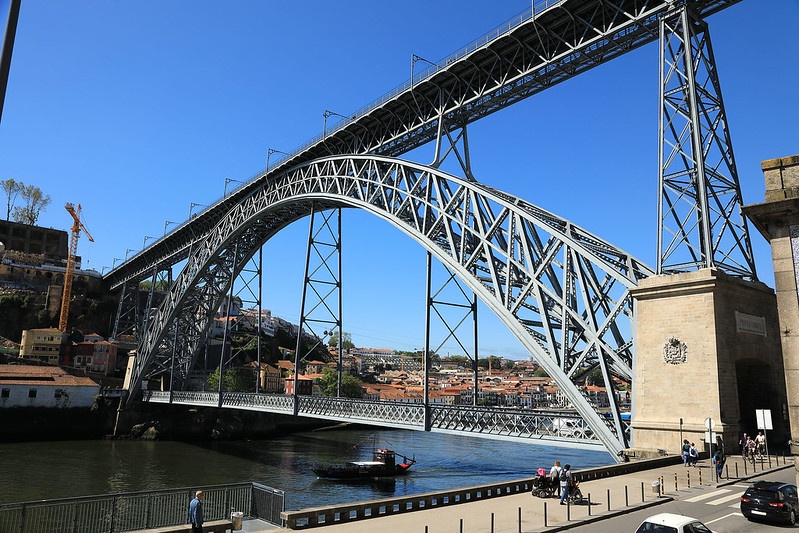 Dom Luís I Bridge over the Douro River |
Our path down to the river followed a series of steep narrow lanes, several with steps in them, winding between old houses built close to one another, cascading down the hillside. This gave us many good photo opportunities. Eventually we reached the river bank, where there was a series of market stalls running west of the bridge.
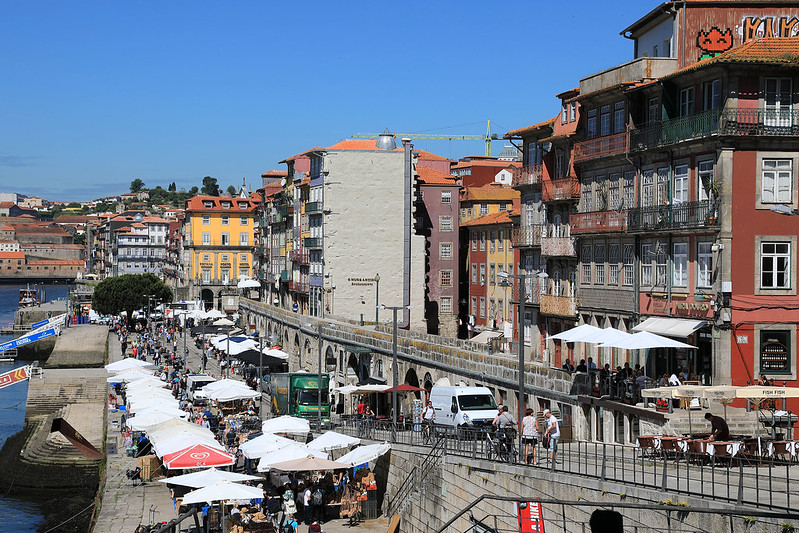 Markets on northern bank of the Douro River |
We decided to cross to the opposite bank and check that out first, then return and walk along the bank on this side. The bridge crossing was slightly precarious as the footpath was steel plates worn smooth by thousands of feet, and barely wide enough for two people to pass without falling onto the road, where cars and buses passed by just centimetres away. The views were wonderful though, along the river with colourful traditional boats playing back and forth (mostly full of tourists), and up the steep banks on both sides with colourful houses perched on top of one another.
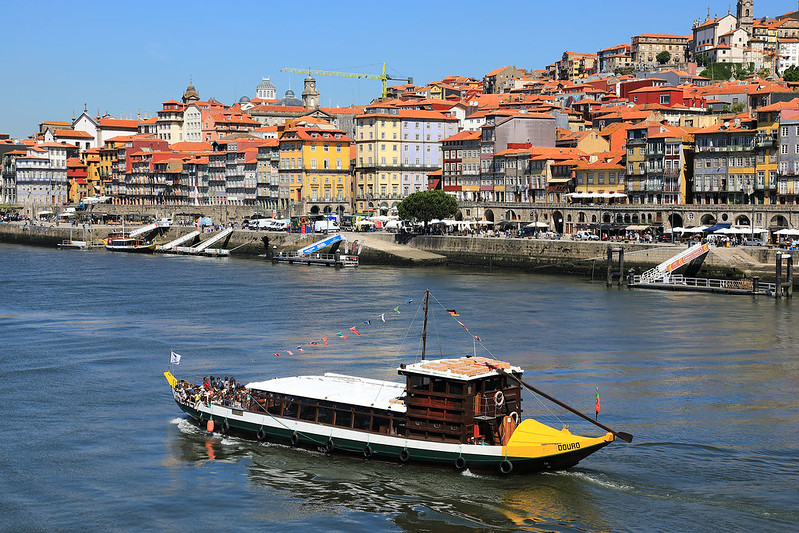 Douro River viewed while crossing Dom Luís I Bridge |
On the south bank of the Douro, we walked over to the market along the river bank. M. browsed the stalls while I went to the edge of the path by the river to take photos of the boats there loaded with barrels.
 Market on southern side of the Douro River |
Presumably in days of yore these would have been genuine barrels full of port wine, but it’s possible these were only here for display, as the boats had names of wineries on them and there was no sign of any sort of shipping activity taking place. This bank of the river contains the caves used for maturing barrels of port for the past few centuries, and is home to dozens of wineries. Many have tasting rooms on the waterfront street, and a few offer tours of their maturing caves, accessible directly from the showroom shopfront.
 Port barrels on boats on the Douro River |
We stopped in at one winery, Ramos Pinto, and asked about a tour of the caves. The woman there said that they only ran tours every 20 minutes from 14:00, but we could book a spot for this afternoon. She said that the first person to book a tour time got to choose the language for the guide’s commentary, and English was already chosen for the 17:00 tour, but others were currently free. We didn’t know where we’d be in the afternoon, and didn’t fancy crossing the river multiple times to come back, so we left it. We did however pick up a couple of sample packs of four different types of port to take home for gifts for M.’s and my mothers. We asked if they served coffee in their tasting room, thinking we could sit in here and relax for a bit with M. having a coffee while I tried some of the ports, but the woman said they didn’t have coffee, but every cafe along the waterfront would sell both coffee and port.
So we left Ramos Pinto and walked along a bit until we found a nice looking place called Casa do Galo, or “House of the Rooster”. This was actually a wine shop, but it also had cafe tables outside on the street facing the river, and a menu that included coffee and port tasting flights. M. asked the waiter for a caffe macchiato, but he said they only did espresso. M. asked if they had milk, but he said no, only black. M. decided that was okay, and ordered one, plus a bowl or almonds to nibble on. I looked at the port tasting options. There were six different choices, the cheapest being “Taste for Nurdes” for 6€, with three different ports to sample. Next was “Lady’s Choice”, followed by the “Level 1 Tasting”, again each with three ports. From here on the samples got larger, until the ultimate option cost 42€ and included samples of seven different ports. I chose the Level 1, which cost 11€, figuring they must be nicer than the cheaper options.
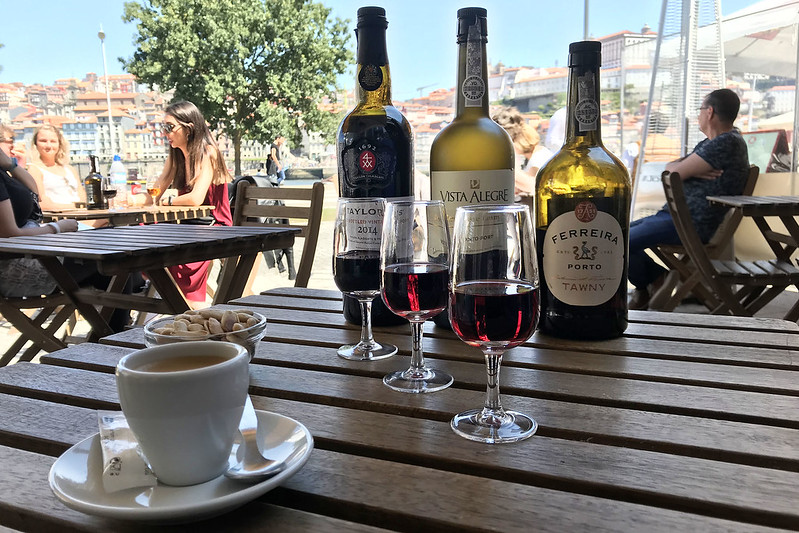 Port tasting for morning tea! Casa do Galo |
The waiter brought out the coffee and almonds and three port glasses, then three bottles of port. He explained what they were, how long they’d been matured, and a bit about the flavour characteristics of each one before pouring them, and recommending the order in which to try them. The first two were tawny ports, matured 5 years and 7 years respectively, and the last was a 2014 single vintage port, which he said was sweeter. The 7 year was definitely smoother and more complex than the 5 year, but honestly I couldn’t tell much of a difference between the 7 and the vintage – at least in taste, because the vintage was a darker, deeper red colour. M. said her coffee was fine without the milk; she just doesn’t like bitter coffee and milk helps hide that, but this one wasn’t bitter.
After finishing our almonds and drinks, we continued walking back along the riverside to the bridge we’d crossed earlier, and then crossed to the north bank. Here there were more market stalls running west along the river, mirroring those on the south side.
 Northern bank of the Douro River |
We walked along here for a few blocks, before turning north up the hill to explore the interior of the maze of small streets and stepped paths. We walked around for some time, turning corners and encountering photogenic views of the tightly spaced buildings at many places. It was very much like getting lost exploring Venice, if only Venice had been built on a steep slope rather than water level. Some of the areas were touristy, with modern restaurants and cafes spilling into outdoor seating. Other places were worn, dusty little nooks where old rotting wooden doors opened into houses populated by old people whose families have probably lived there for hundreds of years, with laundry hanging out to dry from upper level windows and flea-bitten cats lazing on window sills and door thresholds. But even in these places we passed other tourists, similarly wandering at random just to see whatever was there.
 Tight alleys of Porto |
After doing several traverses, loops, climbs, and descents, we ended up near the small square where we’d had dinner at Puro 4050 last night. Here we found a small, somewhat weary looking cafe called Cafe São Domingos, on the street of the same name. We went inside and there were three very cramped small round tables, being all that could fit into the interior space in front of the counter. We decided to sit outside, where there were ten or so larger square tables on the cobbled slope of the footpath. The tables and chairs had leg extensions on one side so they could sit at an angle approximating level on the sloping ground. M. had a croissant and a hot chocolate, while I ordered a “wrap frango”, or a chicken wrap. The wrap arrived after M. had finished, and consisted of crumbed chicken strips in a tortilla with lettuce, cheese, tomato, and corn kernels, with a bit of mayonnaise and a treble clef of balsamic vinegar on the side of the plate. The chicken was hot and it all tasted pretty good, making a perfectly fine lunch.
After recharging we walked back down the hill to the river again, further west this time, to explore more of the historic town region. Again it was a mixture of touristy spots and hidden alleyways leading to rustic sights. It seems a lot of tourists do this sort of semi-random wandering around this area. During all this wandering we ended up stumbling across four or five churches at various points, poking our heads inside to look around when we could, getting photos of the Igreja de São João Novo.
 Igreja de São João Novo |
The Monument Church of São Francisco was charging 7.50€ for entry to the church, a religious museum, and the catacombs. We decided to pay and do the tour as it seemed like one of the more important sites and we wanted to be inside out of the afternoon sun for a bit. The museum section was fairly impressive, with a lot of painted wooden sculptures, paintings, ornate vestments, and silver items, some plated with gold.
 Religious museum, Monument Church of São Francisco |
The catacombs were much more spacious than I was expecting, being large, airy, light rooms below ground level, with the walls lines with tomb spaces painted white with names in black text, and the floor being a grid of tombs with numbered wooden lids separated by narrow strips of granite. There were several rooms and must have been a couple of hundred or so people in individual tombs. But at one point there was a glass window in the floor showing that underneath was an ossuary piled deep with random bones, including several skulls from what we could see. A sign indicated that after the bodies had decayed the bones were removed from the tombs and placed into the ossuary. The church itself was amazing, however photography was not permitted, so I didn’t get any photos of this one. Almost every surface, including the ceiling, was covered in ornately carved wood, covered in gold leaf. The gold had partly worn away, leaving an impression of mixed dark wood and gold. One section of wall had a huge carved tree, its roots wrapped around a body of someone at the bottom, and branches leading up to support twelve people, possibly the apostles, surmounted by Christ at the top.
 Catacombs, Monument Church of São Francisco |
Back outside, we stopped for an afternoon snack at an ice cream place called Boutique do Gelado. M. had a scoop of Fererro Rocher ice cream, I had two scoops with pistachio and strawberry cheesecake flavours. We also grabbed some of the water in decanters on the counter. They had disposable plastic cups, all stickered with their logo. We spent some time sitting here, resting out of the afternoon heat. It continues to be much warmer than any of the weather forecasts we’ve been seeing.
We headed more generally uphill late in the afternoon. We found ourselves at the Igleja dos Clérigos, which is a church with a tall bell tower attached. Perched near the top of a hill, the tower is visible from most places we’d been that had any view at all (as opposed to being on a steep path in a canyon of buildings), so we were already familiar with it. They allowed entrance to the church for free but were charging people to climb the tower. Being late in the day and fairly worn out from all the walking, and having spent a bit on various attractions already, we decided against going up.
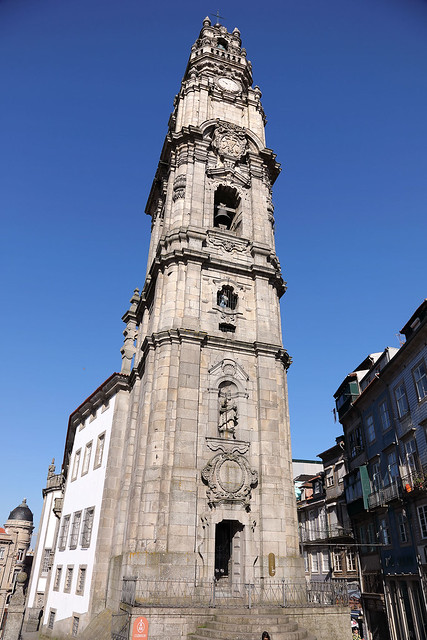 Igleja dos Clérigos |
We crossed a main road out of the historic district to check out a small area that our paper map indicated was full of bars, and where I’d found some tapas bars on Google Maps, to see if we could find anything that looked good for dinner. The streets seemed rather quiet, since it apparently wasn’t opening time yet for many of the places, although some were open. We found a tapas place or two, but the menus didn’t promise much that was meat-free, so we kept going. A few of the places looked like they had decent food, but the decor was a very loud, dark, neon bar vibe, which was not great for a nice quiet dinner.
Right at the end of this area we found an Italian place called Il Pizzaiolo. We went in and found the restaurant to be completely empty except for two guys behind the counter who were busy preparing things.They didn’t notice us for a few seconds and then when one did he ran to the back of the restaurant and called another guy out, telling him to get his act together, there were customers. He seated us at a table but said that we could only order pizzas, not pasta or risotto or salads because the kitchen was closed and only opened at 19:00. We said that was fine and perused the menu. We ordered some garlic bread, a vegetarian pizza for M. and a gamberetti for me, which was garlic prawns, asparagus, micro coriander, rocket leave, and chilli.
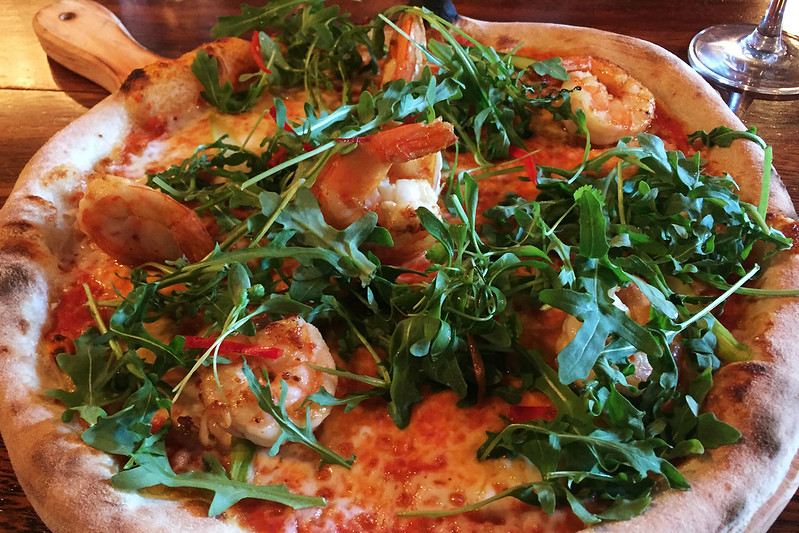 Gamberetti pizza, Il Pizzaiolo |
While we waited for our meals, two women arrived and walked into the back of the restaurant, obviously staff arriving for work after us! The garlic bread was a smallish kiwifruit-sized lump of pizza dough each, baked in the wood fired oven then cut in half and stuffed with garlic butter. It was delicious but small, although when the pizzas arrived we were glad the bread hadn’t been larger. The pizzas were generous for single serves, with a thick doughy crust blistered by the oven and a paper thin base topped with the toppings in the middle. They were extremely good. With the pizzas M. had a red wine while I had a Vinho Verde. The wines and meal were inexpensive, so it was nice to get a good feed without breaking the bank.
After eating we walked back to the hotel, taking a different route home. Near the pizza place we passed a pasteleria named O Forno dos Clérigos which had enormous things that looked like vanilla slices in the window, giant cubes of almost entirely filling with thin sheets of pastry on the top and bottom. I thought I had to try one, so M. bought one to take away and I ate it later back in the hotel. It turned out the filling was marshmallow, not custard, and the slices wasn’t really that great. Oh well, at least we had a good dinner before.
 The faux vanilla slices |
On the way into the hotel we stopped to ask how much the breakfast was (6.90€, which we thought was reasonable and would probably do tomorrow morning) and what time check out was (12:00, which was perfect because we wanted to leave about then anyway to go to the railway station for our train to Lisbon).
